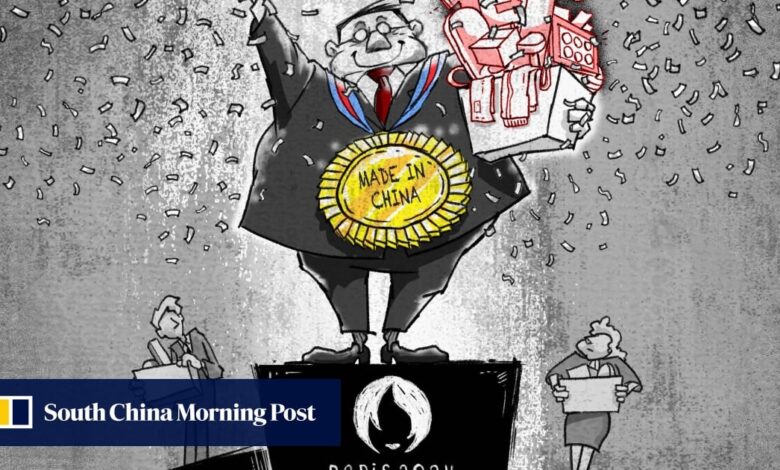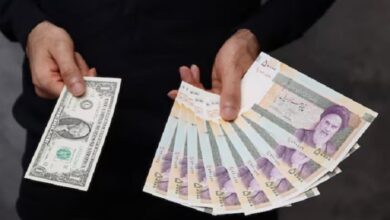At Paris Olympics, Chinese manufacturers won big before the Games even started

Yan Zaixing is general manager of Sonic Composite Technology – the only manufacturer selected to provide windsurfing equipment for the Paris Olympics, which begins with the opening ceremony on Friday.
Yan said that “there are almost no comparable competitors” – in terms of the iterative speed of new materials and production process – in the same field, and this makes his company stand out from the crowd.
“I think that is key to successfully winning an order for the Olympic Games,” he added. “We are the only company in the world that covers the whole industrial chain to produce high-performance hydrofoil equipment.”
The official Olympics website explains how the windsurfing race, to be held in Paris’ Marseille Marina, features a new format called iQFOiL this year, replacing the old Olympic format known as RS:X. The main difference is that the daggerboard – a kind of retractable centreboard through the keel of a sailboat – has been replaced by a foil.
“So, instead of floating, the board appears to fly thanks to the use of hydrofoils attached to the bottom of the board that lift the board completely out of the water at planing speeds,” the official website of the Games explained.
As manufacturers and suppliers cope with cost concerns and geopolitical situations, some low-end manufacturers have shifted operations from China to places such as Vietnam and India.
But industry players say that the holistic, comprehensive and well-organised supply-chain network built over decades is what has reinforced a global reliance on the world’s second-largest economy.
Paul Tai, regional director at global retail solutions provider and manufacturer Mainetti Group, explained that there is not a lot of time to fulfil an order for a world event such as the Olympics. And he added that there are no second chances to get the orders right.
“Not many places can do it, given the fact that they have to deliver within a short period of time with good quality and standards,” he added, noting that there were structured clusters in China, and that suppliers know where to buy various materials.
Chinese manufacturing will move up the value chain by using more artificial intelligence or automation in the production process
Tai’s company produces souvenirs for Chinese gymnasts for the Paris Olympics and supports the Chinese sports-equipment company Anta by providing accessories such as clothing hangers to the Chinese team. Before that, Tai’s firm had been a working partner of the International Olympic Committee since 2020, providing packaging products for the Tokyo Olympics and the 2022 Beijing Olympics.
Tai added that China’s manufacturing sector has become “pretty cost-competitive” over the past 30 years, with many factories producing high-level original equipment.
“Going forward, Chinese manufacturing will move up the value chain by using more artificial intelligence or automation in the production process,” he noted.
Adding to the sectoral transformation, according to Fan Di, an associate professor and assistant dean for fashion and textiles at Hong Kong Polytechnic University, many buyers have developed mature corporate-social-responsibility systems with their Chinese suppliers over the past decades.
“Whether it be Malaysia, Vietnam or India, they’re slower than China in terms of building globally recognised systems,” Fan said.
According to French weekly news magazine L’Express, 90 per cent of the Paris Olympics mascots are made in China. And Chinese state media Xinhua reported that various types of Olympic souvenirs, including caps, T-shirts, toys, pens, wristbands and notebooks being sold in Paris were “made in China”, and that some manufacturers started getting orders in the second half of last year.
Other Olympics-related products – from the athletes’ sportswear to lazy sofas used in the Olympic Village – were made in the eastern province of Zhejiang, Xinhua said.
State media also said that other sports gear came from the northeastern province of Shandong, including road-race bikes used by the Chinese national team.
“Although labour costs have risen in China, logistics, work efficiency and transport are much better in China than in those Southeast Asian countries,” said Qiu Dongxiao, head of economics at Lingnan University in Hong Kong.
The Chinese manufacturing sector is very large, he added, and it is hard to find such a scale in other countries.
“For products such as souvenirs and sports items, they are less politically sensitive and face less geopolitical risk by staying in China,” Qiu explained.
Customs authorities in Xiamen, Fujian province, said 1,116 sets of apparel and gear were exported on June 21 for the International Olympic Committee work staff, and the shipment was one of the largest batches of goods that China has sent to Paris.
And customs data from Hangzhou, Zhejiang province, indicated that the value of sports-related exports from the province exceeded 10 billion yuan (US$1.38 billion) between January and April – a nearly 25 per cent increase from a year earlier and accounting for a quarter of the country’s total such exports.
Data from e-commerce giant Alibaba also showed a jump in exports of sports equipment to France in March, and popular items including tennis attire, custom sportswear, training helmets and golf bags. Alibaba is the owner of the South China Morning Post.
“In China’s case, even though it has become a world leader in many advanced manufacturing sectors, not all of the low-end manufacturing has migrated out,” said Stephen Olson, a senior adjunct fellow at the Pacific Forum and a visiting lecturer and non-resident fellow at the Yeutter Institute in the US state of Nebraska.
“China remains competitive at both ends of the spectrum,” he added. “Over time … I would expect to see more low-cost manufacturing move to lower-cost locations such as Vietnam or India, but at least for now China has unique competitive advantages.”
China now does not need such a world event to promote its products overseas
Qiu with Hong Kong’s Lingnan University said that other places such as Vietnam and India would not be able to supplant China’s role in the next four years, in terms of producing supplies for world events.
“Given the limited capacity of those countries’ productions [compared with] the excellent production and services environment in China, multinationals will not leave China too fast,” he noted.
“China now does not need such a world event to promote its products overseas, given its economic and trade performances in the past decades,” Qiu said. “What China needs to do is to move up the value chain, improve production quality and further innovate.”
Yan at Sonic Composite Technology Company, the windsurfing-equipment producer, said his company is looking to build an assembly plant in the European Union. That, he said, would allow the firm to ship from there with less logistical constraints and shorter lead times, to better serve its global customers.
Meanwhile, Tai at Mainetti Group said that some countries now prefer to develop their high-end and hi-tech manufacturing sectors, aiming to boost GDP growth.
“[Those countries] would rather buy from China than make [low-end products] themselves,” he added. “Some manufacturers may build factories elsewhere, due to geopolitical concerns, but eventually they have to buy parts and materials from China for assembling – this is what ‘China plus one’ means.”
Source link




